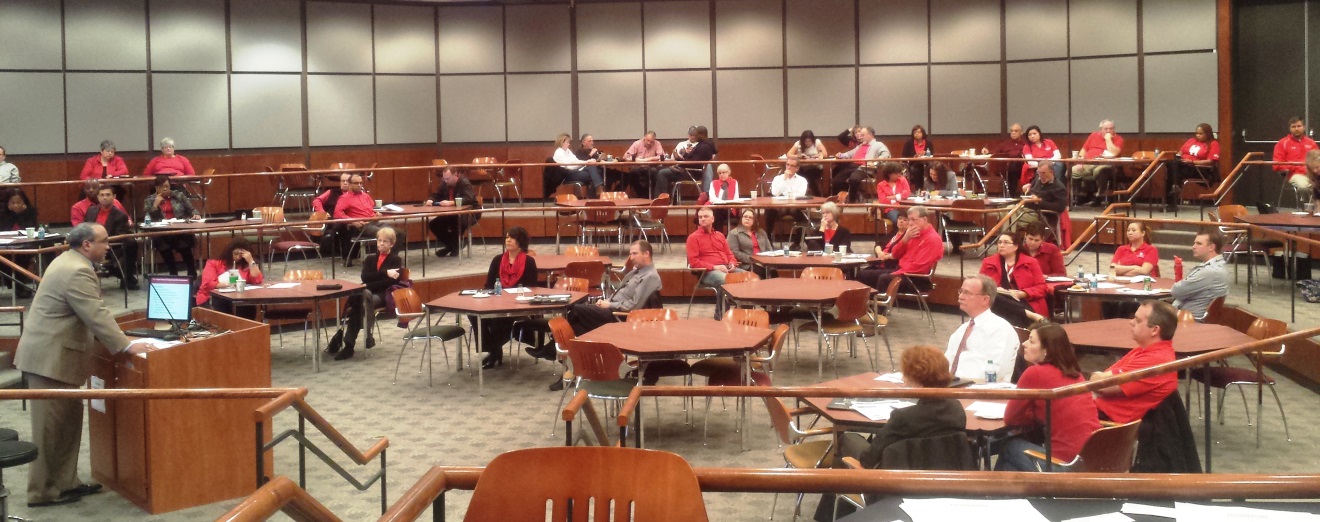University building coordinators met February 28 for the second quarterly meeting of the fiscal year. They gathered in the Kiva Room of Farish Hall to learn important information that will help them as they serve in the role of building coordinator and point of contact for their facilities and building occupants. Presentation topics included capital planning and capital improvement, Facility Condition Assessment updates and next steps, and access control.
The meeting began with a presentation by Jonathan Thurston, executive director of Facilities Planning and Construction, about the University's major capital construction projects. In 2013, Facilities Planning and Construction (FPC) completed seven capital projects and 502 minor projects. FPC has four projects under construction and four more that are coming soon.
With the recent integration of Minor and Planned Projects, FPC is now formally composed of Planning, Capital Project Management, Facilities Information, Project Inspections/QA-QC and Non-capital Project Management.
Jim Norcom, director of Compliance and Emergency Programs for Facilities Management, gave an overview and update of the Facility Condition Assessment, which was initially started in 2011. This comprehensive assessment will provide rich data and information on University facility physical needs and will help establish criteria that will be used to support the master and long-term capital plans.

Jim Norcom presents at the Building Coordinator Quarterly Meeting
Facilities Management's Sameer Kapileshwari, interim executive director, and Avinash Rahurkar, interim associate director, gave a presentation on the Facility Condition Assessment's next steps, which include prioritizing needs and alignment with academic and master planning efforts (Capital Improvement Plan) with full plan implementation by fiscal year 2014.
Moving forward with the assessment results will require an integrated strategy with communication as the key to the process. Kapileshwari and Rahurkar shared that there are proposed summer projects already planned that include addressing electrical, water and HVAC issues identified in the assessment reports.
Director of Planning Mike Yancey and Assistant Director of Planning Jeanne LaMontagne provided a Capital Improvement Plan (CIP) update. The CIP is a five-year plan that identifies planned capital projects, providing a link between the campus strategic plans and the University's capital budget; this program will incorporate key aspects of the Facility Condition Assessment data for inclusion in the capital improvement planning process.
Associate Vice President/Vice Chancellor Malcolm Davis, Public Safety and Security, gave a presentation and update on University access control with examples of the various card and non-card readers currently being installed across campus. Davis indicated that as the access control project continues, updates will be distributed to building occupants via their building coordinators.
There was a brief demonstration of a soon-to-be-rolled-out building coordinator option as one of the new features of FAMIS self-service by Facilities Management Senior IT Business Analyst Khanh Hodges.
Facilities Management Communications Manager Jacquie Vargas closed with a review of building coordinator expectations and the reaffirmation and recognition of the vital role of the building coordinator.
To learn more about the Building Coordinator Program and view a list of the building coordinators, along with the full slide presentation from the quarterly meeting, visit the Building Coordinator Program section of the Plant Operations website. The next Building Coordinator Quarterly Meeting is scheduled for May 16, 2014.
To learn more about the programs and services of Facilities Management, visit the Facilities Management section of the Plant Operations website, the Plant Operations Facebook page or tweet us @uhplantops.